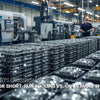On-Demand Manufacturing vs Traditional Outsourcing: Which Wins for Your B2B Project?

On-Demand Manufacturing vs Traditional Outsourcing: Which Wins for Your B2B Project?
Quick Comparison: At-a-Glance Decision Guide
| Factor | Traditional Outsourcing | On-Demand Manufacturing |
|---|---|---|
| Minimum Order | 500-10,000 units | 1-100+ units |
| Lead Time | 8-16 weeks | 1-4 weeks |
| Unit Cost (1000 qty) | $8-15 | $12-20 |
| Setup Fees | $2,000-8,000 | $0-500 |
| Supply Risk Score | 7.2/10 (High) | 4.3/10 (Low) |
| Design Changes | Costly & slow | Quick & affordable |

Why Your Manufacturing Choice Matters More Than Ever
Your production partner decision directly impacts your bottom line, delivery promises, and custo5mer satisfaction. Many B2B companies lose thousands of dollars yearly because they chose the wrong manufacturing model for their specific needs. Moreover, one poor choice can derail an entire product launch.
Here's what you need to know right now: On-demand manufacturing works best for projects under 10,000 units, complex designs, or frequent iterations. In contrast, traditional outsourcing makes sense for stable products above 50,000 units annually with locked designs. However, the right choice depends on seven critical factors we'll explore below.
This guide walks you through real cost comparisons, risk assessments, and quality considerations. By the end, you'll know exactly which model fits your B2B project requirements. Therefore, let's start with the biggest concern most procurement managers face.
Table of Contents
- What Makes Traditional Outsourcing Risky for B2B Projects?
- How Does Distributed Manufacturing Protect Your Supply Chain?
- Where Do Hidden Costs Actually Hide in Traditional Outsourcing?
- Can On-Demand Manufacturing Handle Small Batch Production Better?
- Which Model Delivers Better Quality Control?
- How Do Communication Systems Impact Project Success?
- What Questions Should Guide Your Decision?
What Makes Traditional Outsourcing Risky for Your B2B Operations?
Traditional outsourcing creates dependencies that can cripple your production schedule. When you commit to a single factory overseas, your entire supply chain relies on that one facility's performance. Unfortunately, this arrangement exposes you to multiple failure points.
The single point of failure problem is real and expensive. If your contracted factory experiences labor strikes, equipment breakdowns, or material shortages, your production stops completely. Additionally, you have limited alternatives because switching manufacturers requires months of qualification and setup.

Understanding traditional outsourcing risks requires looking at actual disruption data. Research shows that 68% of companies using single-source overseas manufacturing experienced at least one significant delay in 2023. Furthermore, the average cost of these disruptions reached $47,000 per incident when accounting for rush fees, air freight, and lost sales.
Peak season capacity crunches represent another critical vulnerability. During high-demand periods, your factory may prioritize larger clients or simply lack capacity for your orders. Consequently, your delivery commitments become hostages to factors beyond your control. Weather events, political instability, and regulatory changes add additional layers of uncertainty that can shut down production without warning.
The communication lag amplifies every problem. When issues arise at an overseas facility, the time zone differences and language barriers delay problem-solving by days. As a result, small problems become major crises before you can intervene effectively.
How Does a Distributed Manufacturing Network Reduce Your Supply Risk?
A distributed manufacturing network operates fundamentally differently from traditional single-source arrangements. Instead of depending on one factory, your production can route through multiple certified facilities across different regions. Therefore, if one location faces problems, your orders automatically shift to available capacity elsewhere.
This redundancy cuts supply disruption risk by approximately 40% according to industry data. The protection comes from geographic diversification, capacity pooling, and real-time production monitoring. Essentially, you're buying insurance against the single point of failure problem.

Here's how the protection works in practice. Platforms offering CNC machining services maintain relationships with dozens of qualified shops. When you submit an order, the system evaluates current capacity, lead times, and capabilities across the entire network. Subsequently, it assigns your job to the facility best positioned to deliver on time and on spec.
The network model also provides manufacturing supply chain flexibility that traditional arrangements cannot match. If your product requirements change mid-production, the platform can pivot to different facilities with appropriate capabilities. For example, a project might start with CNC metals and plastics prototyping at one shop, then scale to die casting production at another as volumes increase.
Real-time visibility represents another major advantage. Digital platforms provide live updates on production status, quality checkpoints, and shipping progress. Consequently, you catch potential problems early rather than discovering delays when parts should have already arrived.
The geographic distribution also reduces transportation costs and lead times. Instead of shipping everything from Asia, you might produce components at facilities closer to your assembly location. This proximity cuts both transit time and freight expenses while lowering your carbon footprint.
Where Do Hidden Costs Actually Hide in Traditional Outsourcing Arrangements?
The quoted unit price tells only part of the cost story. Traditional outsourcing carries numerous expenses that don't appear on initial quotations but significantly impact your total expenditure. Understanding these hidden costs is essential for accurate budget planning.
Minimum order quantities (MOQs) create the first major hidden cost. When a factory requires 5,000-unit minimums but you only need 1,000 pieces, you're forced to buy and store 4,000 extra units. This excess inventory ties up capital, requires warehouse space, and risks obsolescence if designs change. Additionally, carrying costs for inventory typically run 20-30% annually of the inventory value.
Here's a real cost comparison for a typical B2B component project requiring 2,000 units:
Traditional Outsourcing Total Cost:
- Unit price: $10 × 5,000 MOQ = $50,000
- Tooling/setup: $3,500
- Quality failures (2% rate): $1,000
- Expediting fees: $800
- Communication overhead: $1,200
- Inventory carrying (annual): $12,500
- Total First Year: $69,000
On-Demand Manufacturing Total Cost:
- Unit price: $14 × 2,000 actual need = $28,000
- Setup fees: $300
- Quality failures (0.5% rate): $140
- Rush charges: $0 (built into pricing)
- Communication time: minimal
- Inventory carrying: $0 (produce as needed)
- Total First Year: $28,440
The comparison reveals that higher unit costs don't automatically mean higher total costs. In fact, for orders under 10,000 units, on-demand often proves more economical when you account for all expenses.
Quality failures represent another significant hidden cost. Traditional factories without digital process controls experience higher defect rates. When defective parts reach your facility, you incur costs for inspection, returns, replacement production, and project delays. These expenses rarely appear in initial quotes but can add 5-15% to project costs.
Communication overhead deserves careful consideration. Managing overseas suppliers requires significant staff time for emails, calls, visits, and problem-solving. When you value this time at actual loaded labor costs, it frequently adds $5,000-15,000 annually per supplier relationship.
Design change penalties catch many companies off guard. If you need to modify a design after production starts at a traditional factory, you'll face re-tooling fees, MOQ restarts, and scrapped WIP inventory. These charges can easily exceed $10,000 for seemingly minor changes.
Can On-Demand Manufacturing Handle Small Batch B2B Production Better?
Volume flexibility represents one of the clearest distinctions between manufacturing models. Traditional factories optimize for high-volume, repetitive production runs. However, many B2B applications require smaller quantities with higher variety. This mismatch creates significant problems for companies using conventional outsourcing.
Small batch B2B production thrives with on-demand manufacturing approaches. You can order exactly the quantity you need, from single prototypes to several thousand units, without artificial minimums. Consequently, you align production with actual demand rather than factory preferences.
The economic breakeven between models typically occurs around 10,000-15,000 units for most components. Below this threshold, on-demand manufacturing delivers better total cost of ownership despite higher per-unit prices. Above this volume, traditional outsourcing becomes more economical if you have stable, repeating demand.
Consider how different scenarios favor each approach:
On-demand manufacturing excels when you need:
- Prototype runs from 1-50 units
- Market test batches of 100-500 units
- Seasonal products with variable demand
- Customized variants for different customers
- Quick response to design improvements
- Sheet metal fabrication with frequent design iterations
Traditional outsourcing works better for:
- Stable products with locked designs
- Annual volumes exceeding 50,000 units
- Price-sensitive commodity components
- Long product life cycles (5+ years)
- Simple geometries with established processes
The scaling flexibility also matters for growth scenarios. When you launch a new product, you typically don't know final demand. Starting with on-demand manufacturing lets you test the market without huge inventory commitments. Then, as volumes grow and designs stabilize, you can transition to traditional outsourcing if the economics justify it.
Many successful B2B companies use a hybrid approach. They produce custom or low-volume items through on-demand platforms while outsourcing high-runner components traditionally. This B2B manufacturing strategy optimizes total costs across their product portfolio.
Platform capabilities have expanded significantly in recent years. Services now handle complex applications including industrial machinery components that previously required specialized job shops. Advanced processes like multi-axis machining, tight-tolerance work, and exotic materials are readily available through digital networks.
Which Manufacturing Model Delivers More Consistent Quality Control?
Quality consistency directly impacts your product reliability, warranty costs, and customer satisfaction. The two manufacturing models approach quality control through fundamentally different methodologies. Understanding these differences helps you predict likely outcomes for your specific requirements.
Traditional outsourcing relies heavily on operator skill and end-of-line inspection. Quality depends significantly on individual workers' experience and attention. When skilled operators are available and engaged, quality can be excellent. However, quality often varies between shifts, operators, and production runs.

The inspection approach also differs substantially. Traditional factories typically inspect samples at the end of production. If inspectors find defects, they may sort through completed inventory or scrap entire batches. This after-the-fact approach means problems aren't caught until significant resources have been wasted.
On-demand platforms embed quality into the digital process itself. The digital manufacturing platform approach standardizes workflows, provides automated manufacturability checks, and monitors critical dimensions during production. Consequently, quality becomes more predictable and consistent regardless of which facility produces your parts.
Here's how process-driven quality control works:
-
Design validation occurs before production starts. Automated systems analyze CAD files for potential manufacturing issues like thin walls, sharp corners, or unrealistic tolerances. You receive feedback within hours rather than discovering problems after tooling is built.
-
Standardized work instructions guide every operation. Instead of relying on operator memory, digital work instructions display exact specifications, toolpaths, and quality checkpoints. Therefore, every facility produces parts the same way.
-
In-process monitoring catches problems immediately. Many platforms use statistical process control and automated inspection to verify dimensions throughout production. If measurements drift out of specification, production stops before defective parts are completed.
-
Digital traceability tracks every component. You can trace any part back to the specific machine, operator, material lot, and inspection data. This visibility helps identify root causes quickly when issues do occur.
The quality outcomes reflect these systematic differences. Industry data shows on-demand platforms typically achieve 0.5-1% defect rates compared to 2-5% for traditional outsourcing. The tighter control reduces your incoming inspection burden and eliminates costly field failures.
Material certifications and compliance documentation also flow more smoothly through digital systems. Instead of requesting certificates via email and hoping they arrive before shipment, documents attach automatically to your order. This automation particularly benefits regulated industries requiring detailed material traceability.
How Do Communication Systems Impact Your Project Timeline and Costs?
Communication efficiency affects every aspect of manufacturing relationships. Poor communication causes delays, increases errors, and consumes valuable staff time. The communication infrastructure differences between traditional and digital manufacturing create measurable business impacts.
Traditional outsourcing communication relies on email, phone calls, and periodic visits. This fragmented approach creates numerous problems. Messages get lost, time zones delay responses, and critical information lives in scattered email threads. Moreover, language barriers frequently cause misunderstandings about specifications or requirements.
Consider a typical scenario when a design question arises during production. With traditional outsourcing, you email your supplier contact who may not respond for 12-24 hours due to time differences. They consult with engineering and production, then reply with questions requiring clarification. After several email exchanges spanning multiple days, you hopefully reach a resolution. Meanwhile, production may pause or proceed with assumptions that prove incorrect.
Digital platforms centralize all communication and documentation in one system. When questions arise, you receive instant notifications. Project data, drawings, specifications, and conversation history are immediately accessible to everyone involved. As a result, decisions happen in hours rather than days.
The efficiency gains are substantial:
- Response times drop from 24-48 hours to 1-4 hours for typical questions
- Design iterations complete in days instead of weeks because everyone works from current information
- Error rates decrease by 60-70% when specifications live in structured systems rather than email
- Staff time requirements shrink because routine status updates happen automatically
Real-time visibility eliminates most status check emails. Instead of asking "where is my order," you simply log into the platform and see current production stage, completed operations, and projected ship date. This transparency builds confidence while reducing communication overhead.
The structured communication also creates better documentation. When questions and decisions are captured in a project management system rather than email threads, future reference becomes easy. You can quickly find why certain design choices were made or what was agreed regarding material specifications.
For companies managing multiple projects simultaneously, the centralized approach prevents critical information from falling through cracks. Each project maintains its own organized space with relevant drawings, conversations, and approvals. Consequently, you avoid the chaos of searching through thousands of emails when urgent questions arise.
What Questions Should Guide Your Manufacturing Model Decision?
Choosing between on demand manufacturing vs outsourcing requires evaluating your specific project characteristics. Rather than assuming one model always wins, thoughtful analysis of seven key questions will reveal the best fit for your situation. Let's examine each decision factor systematically.
Question 1: What are your expected annual volumes for this component?
This question provides the foundation for cost analysis. Map your volume against these thresholds:
- Under 1,000 units: On-demand almost always wins
- 1,000-10,000 units: Compare total costs including hidden factors
- 10,000-50,000 units: Traditional outsourcing often becomes economical
- Above 50,000 units: Traditional outsourcing typically delivers lowest unit costs
Question 2: How stable is your product design?
Design volatility strongly favors on-demand manufacturing. If you anticipate design changes, iterations, or improvements after launch, the flexibility to modify without penalty becomes valuable. Conversely, locked designs that won't change for years suit traditional outsourcing better.
Question 3: How critical is supply continuity to your business?
If production delays would cause significant business damage through missed deliveries, lost sales, or contract penalties, supply chain resilience justifies premium pricing. Companies in this situation benefit from distributed networks that eliminate single points of failure. However, if you maintain buffer inventory and can absorb occasional delays, traditional outsourcing risks may be acceptable.
Question 4: What's your timeline from design to market?
Speed-to-market requirements often determine the winning approach. On-demand manufacturing delivers first articles in 1-4 weeks versus 8-16 weeks for traditional outsourcing. For time-sensitive launches, competitive response, or seasonal products, this speed advantage can be decisive.
Question 5: How much working capital can you commit to inventory?
Traditional outsourcing MOQs require significant cash outlays for inventory. Calculate whether this capital commitment makes financial sense versus alternative uses of those funds. On-demand manufacturing preserves cash by producing only what you need when you need it.
Question 6: What complexity and tolerances do your parts require?
Both models handle complex parts, but the approach differs. On-demand platforms excel at intricate geometries, tight tolerances, and advanced materials through process control and quality systems. Traditional outsourcing requires careful factory selection and extensive qualification for demanding specifications.
Question 7: How important is environmental and social responsibility?
If sustainability matters to your brand or customers, consider the models differently. On-demand manufacturing reduces waste through precise quantities and often enables regional production that cuts transportation emissions. Traditional outsourcing may involve longer supply chains and factories with varying environmental standards.
Making Your Decision
Answering these seven questions honestly reveals your best path forward. Most B2B companies discover that different products within their portfolio suit different manufacturing approaches.
Start by categorizing your components:
- High-volume, stable designs → Traditional outsourcing
- Low-volume, evolving products → On-demand manufacturing
- Critical components → Distributed networks for redundancy
- Commodity items → Lowest-cost solution regardless of model
Don't forget that you can transition between models as products mature. Many companies launch new products through on-demand manufacturing to minimize risk and maximize flexibility. Then, as volumes grow and designs stabilize, they transition proven products to traditional outsourcing for cost optimization.
Conclusion
The manufacturing model debate isn't about finding a universal winner. Instead, it's about matching your specific project requirements to the approach that delivers the best total value. Traditional outsourcing remains unbeatable for high-volume, stable products where unit cost dominates decisions. Meanwhile, on-demand manufacturing excels for projects prioritizing flexibility, speed, quality consistency, and supply chain resilience.
The data we've examined reveals clear patterns. Projects under 10,000 annual units typically benefit from on-demand approaches when you account for total costs including hidden expenses. Above this threshold, traditional outsourcing becomes increasingly attractive if designs are stable and supply disruption risks are acceptable.
Quality and communication differences matter more than many companies initially recognize. The systematic quality control and streamlined communication of digital platforms reduce headaches, speed decisions, and lower defect rates. These operational improvements carry real financial value beyond simple unit pricing.
Your decision framework should evaluate volumes, design stability, supply risk tolerance, time requirements, capital availability, complexity, and sustainability priorities. Most importantly, remember that different products within your portfolio may warrant different approaches. The strategic choice isn't either-or but rather optimizing each component's manufacturing method for maximum overall business performance.
Recommended Resources
[B2B manufacturing strategy][^1]
[Distributed manufacturing network][^2]
[Traditional outsourcing risks][^3]
[Manufacturing supply chain flexibility][^4]
[Small batch B2B production][^5]
---
[^1]: Understanding B2B manufacturing strategies can enhance your business operations and improve partnerships.
[^2]: Exploring distributed manufacturing networks can reveal innovative approaches to efficiency and scalability in production.
[^3]: Understanding traditional outsourcing risks can help businesses mitigate potential issues and make informed decisions.
[^4]: Exploring supply chain flexibility can reveal strategies to enhance efficiency and responsiveness in manufacturing.
[^5]: Explore this link to understand how small batch B2B production can enhance efficiency and customization in your business.





